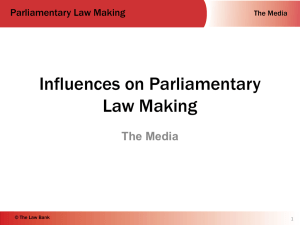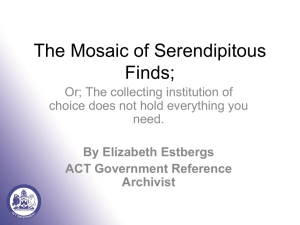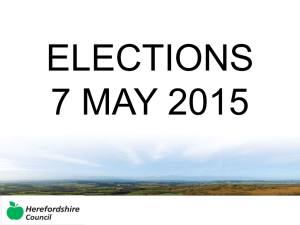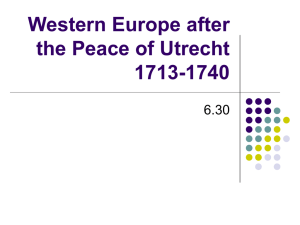Amendment 33 - Parliamentary Zone Review
advertisement
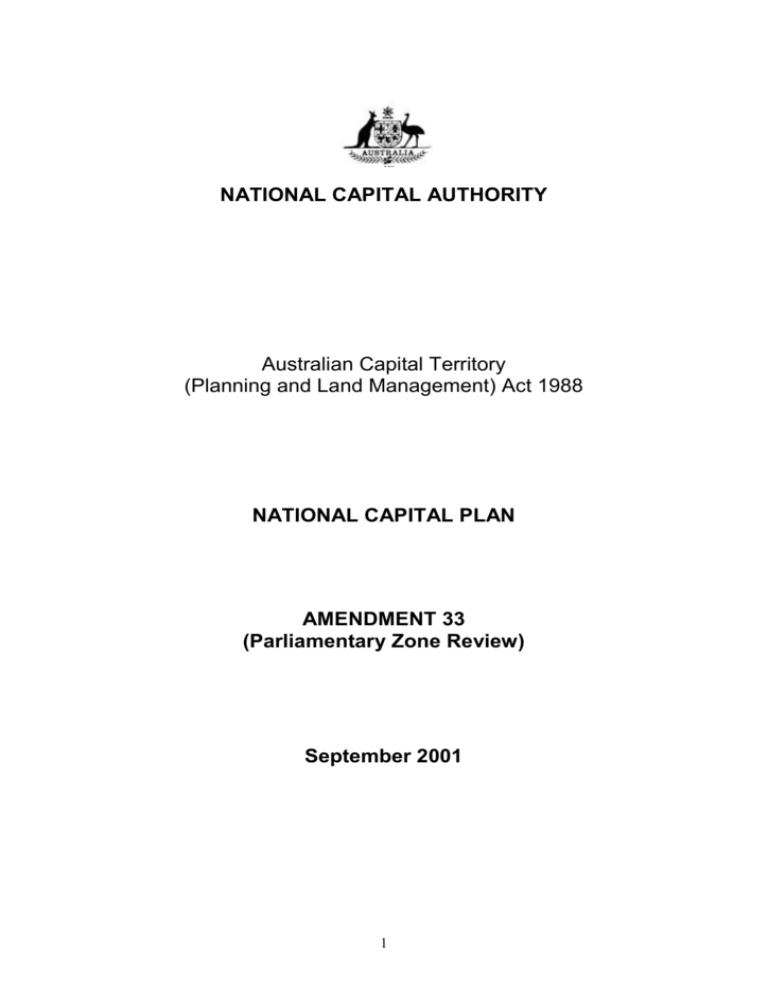
NATIONAL CAPITAL AUTHORITY Australian Capital Territory (Planning and Land Management) Act 1988 NATIONAL CAPITAL PLAN AMENDMENT 33 (Parliamentary Zone Review) September 2001 1 AMENDMENT 33 OF THE NATIONAL CAPITAL PLAN The National Capital Plan is amended by: (i) Replacing the eighth and ninth paragraphs of the Background section of 1.1 The Parliamentary Zone and its Setting with the following Statement of Principles for the Parliamentary Zone (as set out in the Master Plan for the Parliamentary Zone): “A Master Plan for the Parliamentary Zone (refer to Appendix T.6) guides all future development in the Zone. The Statement of Principles set out in the Master Plan is as follows: The Parliamentary Zone will be given meaning as “the place of the people”, accessible to all Australians so that they can more fully understand and appreciate the collective experience and rich diversity of this country. To do this, the place of the people must reflect: The political and cultural role of Australia’s Capital; Federation and Australian democracy; The achievements of individual Australians in all areas of endeavour; The diversity of Australia, its peoples, natural environments, cultures and heritage; and The unique qualities of Australian creativity and craftsmanship. The place of the people must have: (ii) A sense of scale, dignity and openness; A cohesive and comprehensible layout; A large forum for public ceremony and debate; Intimate, enjoyable spaces for individuals and groups; A dynamic program of national, state and regional events; and Public facilities that are accessible and affordable.” Adding the following note to 1.1.2 – Principles for the Parliamentary Zone and its Setting: “Note: Additional Principles specific to the Parliamentary Zone are set out in the Master Plan for the Parliamentary Zone at Appendix T.6.” (iii) Adding the following note to 1.1.3 – Policies for the Parliamentary Zone and its Setting: “Note: Additional Policies specific to the Parliamentary Zone are set out in the Master Plan for the Parliamentary Zone at Appendix T.6.” (iv) Amending policy (i)(b) of 1.4 Detailed Conditions of Planning, Design and Development to refer to the Master Plan for the Parliamentary Zone at Appendix T.6, in lieu of the previous Parliamentary Zone Development Plan. The amended policy reads as follows: 2 “development shall be guided by the principles, policies and Indicative Development Plan for the Parliamentary Zone set out in the Master Plan for the Parliamentary Zone at Appendix T.6.” (v) In Part Two of the Plan, deleting Figure 29 ( Parliamentary Zone Development Plan) and deleting the second dot point on the page previous to Figure 29 requiring the Authority to consider completion of a detailed development plan and program for the Parliamentary Zone (vi) Replacing Figure 5 – The Central National Area (The ParliamentaryZone) of the Plan with an amended Figure 5 (as at Attachment B). and (vi) Inserting the Master Plan for the Parliamentary Zone (Attachment A) into the Appendices section of the Plan as Appendix T.6 – Master Plan for the Parliamentary Zone. 3 ATTACHMENT A APPENDIX T.6 MASTER PLAN FOR THE PARLIAMENTARY ZONE PREAMBLE The Walter Burley Griffin Plan for Canberra was structured on two organising lines – the Land Axis and the Water Axis – and on the great triangle, aligned on the mountains, which created the basic circulation system connecting the government centre south of the lake to urban centres north of the lake. Griffin’s plan for Canberra symbolised democracy and was designed to reflect the values of an emerging nation. In 1998 the Commonwealth Government announced that the National Capital Authority would undertake a strategic review of the Parliamentary Zone and initiate the development of a master plan for that area. The review of the Zone, as a focal point in the Griffin plan, was aimed at refreshing and promulgating the historical visions for the Zone. The review also focused on finding an innovative and practical means of translating a new vision into reality. The Authority carried out the Review with the assistance of a Parliamentary Zone Advisory Panel. The Panel was required to advise on the review process and on the future management of the Zone. The work was completed by the Authority and published in 2000 as The Parliamentary Zone Review Outcomes. Amendment of the National Capital Plan will give a statutory basis to the policy outcomes of the Review. Key results from the Outcomes report are incorporated in the master plan as the first step towards a contemporary formal Commonwealth Government statement about the physical, and cultural development and management of the centrepiece of the National Capital. This master plan is intended to guide decisions relating to development, cultural and physical planning and management within the Parliamentary Zone. It is intended to be a “living” document and, where necessary, subject to successive amendment and further studies as the key outcomes are implemented incrementally. In its present form, this master plan comprises: A statement of principles; A statement of objectives and intentions; Statements of policy relating to the formation of campuses, land use and development, roads and traffic, pedestrian pathways, orientation and interpretation and tree planting; and An indicative development plan. This master plan should be read in conjunction with relevant principles and policies set out elsewhere in this Plan (refer particularly to 1.1 of the Plan) and with relevant 4 Conservation Master Plans. STATEMENT OF PRINCIPLES The Parliamentary Zone will be given meaning as the place of the people, accessible to all Australians so that they can more fully understand and appreciate the collective experience and rich diversity of this country. To do this, the place of the people must reflect: The political and cultural role of Australia’s Capital; Federation and Australian democracy; The achievements of individual Australians in all areas of endeavour; The diversity of Australia, its peoples, natural environments, cultures and heritage; and The unique qualities of Australian creativity and craftsmanship. The place of the people must have: A sense of scale, dignity and openness; A cohesive and comprehensible layout; A large forum for public ceremony and debate; Intimate, enjoyable spaces for individuals and groups; A dynamic program of national, state and regional events; and Public facilities that are accessible and affordable. STATEMENT OF OBJECTIVES AND INTENTIONS To realise the Parliamentary Zone as the place of the people it will be important to: balance politics and culture; welcome people; celebrate Australian history and society; represent Australian excellence; emphasise the importance of the public realm; make access easy and open; reinforce the integrity of the visual structure; strengthen the relationship between buildings and landscape; create a variety of urban spaces; and establish comprehensive design management polices for the future. For each of these objectives, stated intentions that will guide all developmental and cultural and physical planning and management are as follows: 5 Intention Objective Balance politics and culture locate national cultural institutions and key government agencies in the place of the people facilitate the staging of cultural and political events, activities and ceremonies provide opportunities to recognise Australian endeavour Welcome people encourage the diverse population of Australia to visit provide spaces that are pleasant and sheltered improve the level of amenity and engender vitality (cafes, events, picnic spaces, etc) establish a program of appropriate events and activities in quality venues provide visitor-friendly public transport and car parking discourage through-traffic and encourage pedestrians and cyclists make it easy for people to find their destination Celebrate Australian history and society create ceremonial and community events that reflect our nation's history, spirit and aspirations recognise the rich history and contribution of the Indigenous Australian people and of our multicultural society provide opportunities for people to interpret the role of government, the history of our nation and Australian achievement foster a sense of affinity and attachment to the National Capital conserve the unique heritage of the Parliamentary Zone for future generations Represent Australian excellence encourage the exemplary use of Australian innovation, creativity and diversity use Australian materials and craftsmanship demonstrate sustainable management practices adopt best practice design and building procurement Emphasise the importance of the public encourage pedestrian activity 6 realm improve the amenity of the open spaces establish a variety of public spaces that will support a range of activities establish a hierarchy of public spaces with the Land Axis as the principal space create a major focus for public representation provide good signage and interpretative systems Make access easy and open provide a comprehensive system of paths, cycleways and roads make public spaces safe ensure that design is barrier free improve public transport locate car parks where they are central, safe and secure establish well signed, convenient routes to major destinations clearly identify the front entries to buildings Reinforce the integrity of the visual structure maintain the integrity and prominence of the Land Axis symbolically recognise the intersection of the Land Axis and Water Axis emphasise Commonwealth and Kings Avenues as landscape edges align buildings normal to the Land Axis and Water Axis and to Griffin's proposed terraces enhance the existing character and quality of the landscape use lighting to emphasise the organisational structure, buildings and other special features plant trees to reflect seasonal changes Strengthen the relationship between buildings and landscape provide ordered settings and relate buildings of similar functions, using the existing buildings as the focus locate a central court for each development group provide clear address and identity for all buildings from the central court align buildings normal to the Land Axis and Water Axis establish vistas from the Land Axis to the central development courts enhance seasonal, day and night landscape settings for buildings 7 Create a variety of urban spaces establish a sequence of spaces that range from the Land Axis to the development courts provide a major focus for public representation and gatherings of national interest create spaces that will support vibrant activities of discovery and others for reflection or quiet enjoyment link buildings and places with a legible road and pathway network Establish comprehensive design management polices for the future reserve sites for new buildings plan for a mix of appropriate future functions and land uses establish a viable financial framework for development and management provide a defined role for private capital, patronage and sponsorship develop sustainable environmental management practices conserve the unique heritage of the Parliamentary Zone for future generations STATEMENTS OF POLICY Formation of Campuses Identifiable precincts, or campuses, should be created to provide a sensible and flexible rationale for the location of new buildings, public spaces, commemorative works and even some events. Essentially, the policy is to use the existing buildings as 'anchors' for new development that has a compatible function. For example, a new government agency could be sited adjacent to either the John Gorton or Treasury buildings, while a new visual arts building could be located near the National Gallery of Australia. Similarly, any planned extensions to Parliament would be ideally placed on what was Camp Hill between the Old and New Houses of Parliament. While the existing buildings will determine the character of the functions and uses for each campus, a court, plaza or garden should provide the focus to their layout. Each building in the campus, existing and new, should have a pedestrian entry fronting the court, and the courts themselves should be developed so that they encourage people to use them for informal lunch time sports, or for celebrations or perhaps protests. 8 The existing buildings will also influence the architectural and landscape character for each of the campuses. Urban design guidelines addressing aspects such as form, materials, scale and footprint should ensure that successive development contributes to the integrity of the campus. Gradually this will break the Zone into distinguishable precincts, which in turn will make the Zone more visitor-friendly. To ensure that people can move easily between the campuses, the campuses will be connected by paths and vistas created from one central court to the other. To ensure that people can orientate themselves in the Zone, view corridors from the courts to the Lake or Parliament House will also be established. Five campuses are to be formed in the Zone, with Parliament House as a sixth, as follows: 'Parliamentary Executive' campus, centred on Old Parliament House; 'Treasury' campus around that building; 'John Gorton' campus around that building; 'Humanities and Science' campus, built around the National Library of Australia and the National Science and Technology Centre; and 'Arts and Civic' campus built around the National Gallery of Australia and the High Court of Australia. Land Use and Development For the place of the people to remain relevant, a balance should be maintained between the working political functions of the seat of Government and the national cultural institutions. Major shifts in this balance would make the Parliamentary Zone into either a theme park of attractions, or an office environment devoid of people outside of working hours. Permissible land uses include parliamentary uses, appropriate National Capital uses and other uses that enhance the function and character of the area. This can include limited commercial and tourism facilities that support the objectives for the Zone. 9 In recognition of an anticipated 50-year timeframe for future developments including buildings, landscapes and associated works, a number of sites within the Zone should be reserved for future use in four main categories: Seat of Government - Commonwealth Parliament of Australia; Seat of Government - Agencies of the Commonwealth of Australia; National (cultural) institutions; and Facilities and amenities for the public. In the event that Parliament House needs to expand to accommodate growth in its working population, expansion should be directed into the two existing car parks located either side of Federation Mall between East Block and West Block. Buildings should be three storeys in addition to multi-level basement car parking. Future growth of government agency functions should be directed into the campuses located around the Treasury and John Gorton buildings. Because they are near the centre of the Zone and house large worker populations, these two campuses should also be the locations for low-scale structured car parks. The car parks may additionally house future shuttle bus services, as well as limited retail amenities such as dry cleaners, newsagents and flower shops. Any future expansion of the National Gallery of Australia and the National Archives of Australia should occur on sites adjacent to the present locations of these national institutions. Any long-term requirements for new cultural institutions should also be accommodated in the proposed campuses. There are ample new building sites (many currently used for surface parking) associated with the Arts and Civic campus and the Humanities and Science campus. The site to the west of the Land Axis and north of Enid Lyons Street (currently an informal car park) is the highest profile remaining site available for a new building in the place of the people. This site should be reserved for a significant national building, such as a National Theatre and Concert Hall. King Edward Terrace should develop a 'mainstream character' over time with intersection changes, additional pedestrian crossings, broader paths and more consistent avenue planting. To reinforce this character, concessions and convenient services for the public should be provided along the Terrace. Finally, the new focus of public activities in the place of the people – the area adjoining the south side of Parkes Place on the lake edge, and centred on the land axis, should provide amenities and facilities such as restaurants, coffee shops, and exhibitions for the public. Roads and Traffic Traffic is an important issue in the Parliamentary Zone. Commonwealth and Kings Avenues are major traffic routes connecting the north and south of Canberra and both carry large volumes of peak hour traffic. More importantly, commuters travelling to and from Civic, Barton and Fyshwick use the east-west roads that go through the Zone, i.e. King Edward, King George and Queen Victoria Terraces. 10 A disproportionate amount of through-traffic uses King Edward Terrace and as a consequence there are a number of traffic and pedestrian safety problems. These problems include the speed at which traffic moves along King Edward Terrace, the proximity of a number of intersections, the lack of pedestrian crossing points, and poor visibility at intersections and at existing pedestrian crossings. The mix between cars and the large number of commercial vehicles, especially trucks, which use King Edward Terrace, heightens these problems. To assist in ameliorating some of the traffic problems, a number of improvements to the road layout and design should be introduced progressively. These include: Establishing a legible hierarchy in the roads by giving each a different character, drawn from variables such as the road surface and width, avenue planting and directional signage. In this way Commonwealth and Kings Avenues will be distinguished as the primary access roads, King Edward and King George Terraces as secondary address roads and Parkes Place, Queen Victoria Terrace and Federation Mall as the tertiary distributors. The lanes within the campuses that lead to building entries or to car parks should be developed as shared zones for pedestrians and cars; Changing King Edward Terrace from a thoroughfare to a main street. This can be achieved by creating 'T' intersections and traffic lights at its junctions with Commonwealth and Kings Avenues, by rationalising the number of entry points to the campuses and by adding pedestrian crossing points to provide continuity in the path system. With the exception of service vehicles and tourist coaches, a load limit should also be considered as a traffic calming and safety measure; and Removing Bowen Place, Flynn Place, and the straight sections of Langton Crescent and Dorothy Tangney Place. These roads were built to a large scale in the expectation that Parliament House would be built on the lakeshore rather than on Capital Hill. Their removal is possible if 'T' intersections are made at the intersections of King Edward Terrace, Commonwealth and Kings Avenues. Pedestrian Pathways Direct, sheltered paths connecting major destinations will substantially improve the public realm of the Parliamentary Zone. Encouraging people to leave their cars in one destination and to explore the attractions of the Zone as pedestrians will add to the vibrancy and life of the place of the people. A legible and consistent path system, connecting all the parts of the place of the people, will be gradually introduced progressively. The first paths to be installed should be in the northern part of the Zone, linking King Edward Terrace and the lake. Linking with the pathways that now terminate at the northern edge of Parkes Place, the new paths should run down each side of the open space that forms the Land Axis to the lake. Pedestrian crossings are to be provided on King Edward Terrace along these paths at appropriate points to afford a safe pedestrian environment. 11 In the vicinity of Old Parliament House, the existing perimeter roads should be upgraded through the use of extended paving to enhance pedestrian movement but in a manner that has regard to the conservation values of the historic setting of the building and still capable of meeting the functional requirements of the building. This would give the building an appropriate, dignified setting and create a generous new pedestrian environment where currently only narrow footpaths and roads exist. To further connect Old Parliament House with the other parts of the Zone, some form of secondary entry should be created at the rear of the building facing Parliament House. In association with the paths, cycle access for both commuter and recreational cyclists will be provided. The cycleway network should be linked to the existing system, encouraging access and especially cycling around the lake. All major attractions should be similarly connected, and secure facilities for cycle storage should be installed at these locations. Orientation and Interpretation Good orientation and interpretation will help to create a positive first impression and an enjoyable experience for people visiting the place of the people and assist their understanding about the National Capital. A hierarchical signage system that would assist people in finding their way around the Parliamentary Zone and reinforce it as a special area is to be produced. The system should include: identification signs that relate to street entrances of the key national institutions and public places; secondary signs that relate to the public entrances of the buildings; directional signs for traffic and pedestrians to indicate the routes to buildings and other destinations; information signs on services for pedestrians and tourists; and interpretative signs providing information about places, events and venues. This system should ensure continuity in the form of the sign, consistency in message content and easy updating and extension. Interpretative signs are to be included at commemorative and dedication points and at the entrances to gardens, places and venues. These signs should provide brief notes on the historical background, cultural significance and importance of these places. Tree Planting Tree planting is fundamental to the enduring design concept of Canberra and to the character and structure of the place of the people. It is the formal tree planting that reflects the ground pattern of roads and formal spaces and establishes their character and beauty. New planting should be introduced and existing planting strengthened and conserved to attract native birdlife and create shelter, scale, interest and a special character to each of the campuses. 12 The Land Axis and Commonwealth and Kings Avenues are important elements in making the Parliamentary Zone legible. To maintain the definition of the geometry of the Zone, there must be a long-term strategy for the replacement of trees. With its central location, length, width and the stark contrast between the turf and the eucalypts, the Land Axis has a powerful presence in the place of the people. Unfortunately the health and vigour of the trees along the Axis varies considerably and in some areas, especially toward the lake, trees are missing. Trees should be replaced and the planting extended where appropriate to preserve the visual strength of the Land Axis. The tree planting on Commonwealth and Kings Avenues reflects different attitudes to avenue planting over the generations. There is an assortment of native, coniferous and deciduous species that requires rationalisation. The Chinese Elms (Ulmus chinensis) which were planted for quick effect are now compromising the growth of the English Elms (Ulmus procera). Their progressive removal should be continued. The original design intent of the avenue planting - to provide a backdrop of coniferous evergreen trees contrasting with the deciduous trees at the street edge - made the avenues legible in the broader landscape and distinctive throughout the seasons. A consistent approach to replacement tree planting should be undertaken to reinstate this intent. There are other formal spaces that reflect Walter Burley Griffin's plan with its terracing, and the 1920s road layout. These spaces and streets, which include Parkes Place and Queen Victoria, King George and King Edward Terraces, create a series of important cross axes and lateral spaces. The trees that establish these spaces are a mixture of exotic evergreen and deciduous species. A consistent approach to replacement planting should be adopted to conserve the clarity and character of these spaces. For example, red autumn foliage along the avenues, with accents of yellow at intersection points, will help to define special routes and places of interest. The brighter foliage of deciduous trees will also emphasise the major groupings of buildings and offer sun and shade control at various times of the year. The East-West Promenade between the National Gallery of Australia and the National Library of Australia will create a major new lateral space. Here, tree planting should be used to identify this as a new cross axis mimicking the older tree planting of the avenues. INDICATIVE DEVELOPMENT PLAN The Indicative Development Plan at Figure T6.1 indicates how growth and development (in accordance with the principles, objectives, intentions and policies set out in this master plan) is intended to look in the long term. The Indicative Development Plan should be used to guide all future planning and development in the Parliamentary Zone. 13 14 ATTACHMENT B REPLACEMENT FIGURE 5 THE CENTRAL NATIONAL AREA (THE PARLIAMENTARY ZONE) 15


